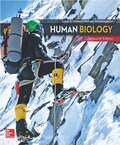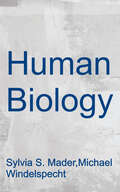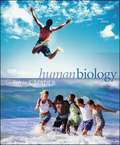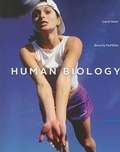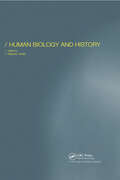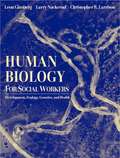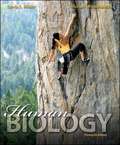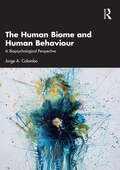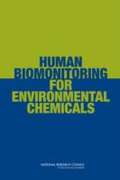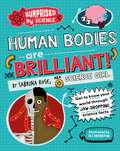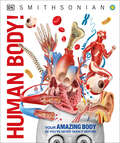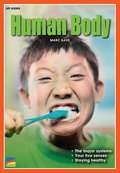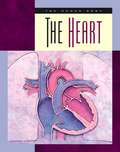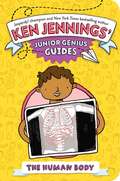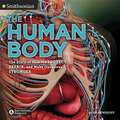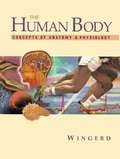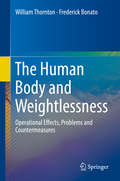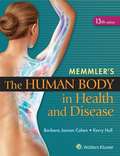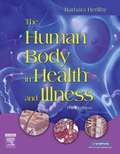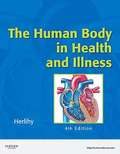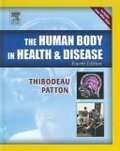- Table View
- List View
Human Biology
by Sylvia S. Mader Michael WindelspechtInstructors consistently ask for a Human Biology textbook that helps students understand the main themes of biology through the lens of the human body. Mader’s Human Biology accomplishes the goal of improving scientific literacy, while establishing a foundation of knowledge inhuman biology and physiology. The text integrates a tested, traditional learning system with modern digital and pedagogical approaches designed to stimulate and engage today’s student. <p><p>Dr. Michael Windelspecht represents the new generation of digital authors. Through the integration of an array of multimedia resources, Michael has committed to delivering the tried-and-true content of the Mader series to the new generation of digital learners. A veteran of the online, hybrid, and traditional teaching environments, Michael is well-versed in the challenges facing the modern student and educator.
Human Biology
by Sylvia S. Mader Michael WindelspechtMader’s Human Biology introduces the main themes of biology through the lens of the human body. Students improve their scientific literacy while establishing a foundation of knowledge in human biology and physiology. The text integrates tested, traditional content with a modern suite of digital tools.
Human Biology (9th Edition)
by Sylvia S. MaderIn this edition, as in previous editions, each chapter presents the topic clearly and distinctly so that students will feel capable of achieving an adult level of understanding. Detailed, high-level scientific data and terminology are not included because Dr. Mader believes that true knowledge consists of working concepts rather than technical facility.
Human Biology (9th Edition)
by Cecie Starr Beverly McmillanPresenting core concepts in a relevant context, Starr and McMillan's HUMAN BIOLOGY gives you a clear understanding of how the human body works and helps you make well-informed choices as a consumer and voter. Each chapter opens with a human biology-related issue currently in the news that highlights the relevance of the topic. You then learn the basic concepts which help you think critically about these issues.
Human Biology and History
by Malcolm SmithThe biology of people in the past is a rapidly expanding field of historical study. Our capacity to understand the biology of historical populations is experiencing remarkable developments on both theoretical and analytical fronts. Human Biology and History weaves together the fields of biology, archaeology, and anthropology in an exchange o
Human Biology (Eighth Edition)
by Daniel D. ChirasA Thoroughly Revised and Updated Edition of an Acclaimed Human Biology TextDesigned for the undergraduate, non-science major, the thoroughly updated eighth edition of Human Biology, continues to present the latest information on the structure, function, health, and disease of the human body, while maintaining the central organizational theme of homeostasis. This acclaimed text explores the world from the cellular level, followed by a look at tissues and organs, and then moves on to a discussion of humans as organisms within a complex evolutionary and ecological environment. Dr. Chiras discusses the scientific process in a thought-provoking way that challenges students to become deeper, more critical thinkers. The focus on health and homeostasis allows students to learn key concepts while also assessing their own health needs and learning how to implement a healthy lifestyle. New to the thoroughly revised and updated Eighth Edition:* Features a reorganized chapter layout so content on the circulatory system and blood are presented before the chapter on nutrition and digestion. * Moved the expanded in-chapter key concepts from the beginning to the end of each section. * Contains new information on numerous topics, including expanded coverage on nutrition and the importance of plant-based nutrients and plant sources of complete proteins, new information on the functions of the appendix, additional information on the benefits of breastfeeding, and new content on the causes and treatment of acne. * New topics added to this edition include primary cilia, hormonal control of hunger, effective treatments for insomnia, use of organs from pigs to repair damaged organs, health benefits of omega-3 fatty acids, new information on HIV infections, genetic determination of sex, natural killer cells, and many more!
Human Biology for Social Workers: Development, Ecology, Genetics, and Health
by Leon Ginsberg Larry Nackerud Christopher LarrisonThis engaging and accessible supplemental text will give students a basic understanding of human biology and how it relates to human behavior and the social environment. It successfully integrates social work theory with human biology theory.
Human Biology (Thirteenth Edition)
by Sylvia S. Mader Michael WindelspechtInstructors consistently ask for a human biology textbook that helps students develop an understanding of the main themes of biology while placing the material in the context of the human body. Mader's Human Biology was developed to fill this void. To accomplish the goal of improving scientific literacy, while establishing a foundation of knowledge in human biology and physiology, Human Biology integrates a tested, traditional learning system with modern digital and pedagogical approaches designed to stimulate and engage today's student. Multimedia Integration: Michael Windelspecht represents the new generation of digital authors. Through the integration of multimedia resources, such as videos, animations and MP3 files, and in the design of a new series of guided tutorials, Dr Windelspecht has worked to bring Dr. Mader's texts to the new generation of digital learners. A veteran of the online, hybrid, and traditional teaching environments, Dr. Windelspecht is well versed in the challenges facing today's students and educators. Dr. Windelspecht guided all aspects of the Connect content accompanying Human Biology. The authors of the text identified several goals that guided them through the revision of Human Biology, Thirteenth Edition: build upon the strengths of the previous editions of the text, enhance the learning process by integrating content that appeals to today's students, deploy new pedagogical elements, including multimedia assets, to increase student interaction with the text, develop a new series of digital assets designed to engage the modern student and provide assessment of learning outcomes.
The Human Biome and Human Behaviour: A Biopsychological Perspective
by Jorge A. ColomboThe book represents a critical update on interactions between the host and its gut microbiome that conditions the socio-biology of the mind and behaviour. Evidence has been scientifically approached and reveals that our conscious behaviour involves a complex interplay of multiple non-conscious domains, including complex host-gut microbiome relationships.The book describes trends and issues on which there is increasing evidence of the impact of host-gut microbiome interactions on behaviour and cultural construction of self-perception. This suggests the need to re-evaluate traditional, basic concepts of human development. Additionally, it calls attention to open issues involving conceptual themes on neurobiological integration and its impact on early developmental and social domains on the typical extended period of human postnatal helplessness during which the basic scaffolding of mental development is completed. It also deals with the impact of poverty and inadequate early feeding habits on individual cognitive development, performance, and social construction. It discusses the need to reformulate views and policies on social marginalisation, child poverty, and malnutrition involving host-gut microbiome imbalances.The spectrum of possible behaviours in all species and its plasticity depends on an integrated vector of basic components involving the genetic code, social and physical environmental, developmental conditions, the relative condition of dominance or submission in social settings –or prey/predator in the Natural Kingdom– and on its physiological and anatomical construction profiles.Graduate, postgraduate and teachers interested in areas connected with anthropology, social medicine, early education, and health policymakers will benefit greatly from this book.
Human Biomonitoring For Environmental Chemicals
by Committee on Human Biomonitoring for Environmental ToxicantsBiomonitoring&#8212a method for measuring amounts of toxic chemicals in human tissues&#8212is a valuable tool for studying potentially harmful environmental chemicals. Biomonitoring data have been used to confirm exposures to chemicals and validate public health policies. For example, population biomonitoring data showing high blood lead concentrations resulted in the U.S. Environmental Protection Agency&#39s (EPA&#39s) regulatory reduction of lead in gasoline; biomonitoring data confirmed a resultant drop in blood lead concentrations. Despite recent advances, the science needed to understand the implications of the biomonitoring data for human health is still in its nascent stages. Use of the data also raises communication and ethical challenges. In response to a congressional request, EPA asked the National Research Council to address those challenges in an independent study. Human Biomonitoring for Environmental Chemicals provides a framework for improving the use of biomonitoring data including developing and using biomarkers (measures of exposure), research to improve the interpretation of data, ways to communicate findings to the public, and a review of ethical issues.
Human Bodies are Brilliant! (Surprised by Science #2)
by Sabrina Rose Science GirlBe surprised by the astonishing science of the human body, with Sabrina Rose, AKA Science Girl, the internet's most inspiring curator of facts and observations of our wonderful world - making it easy for all readers to come to love science!Surprised by Science: Human Bodies are Brilliant brings an attention-grabbing and accessible set of human body facts to life! Doing what she's famous for online, Sabrina Rose dives into the most surprising corners of the human body to explore the science at work. From the clever immune system, to saliva production; from the gut microbiome, to unwelcome invaders - this series is perfect for inquisitive children age 7 and up, and all fans of Science Girl.Surprised by Science is a series of books that takes the inspiring communication and research skills of Science Girl's hugely popular platform and distills it on the page, with funny and engaging illustrations by Ali Ardington paired with photos of the real-life science in action. The series includes: Electricity is Epic!; Plants are Powerful!; Forces are Fantastic!; Sound is Sensational!; Animals are Awesome!; Human Bodies are Brilliant!
Human Body! (DK Knowledge Encyclopedias)
by DKExplore the human body as you&’ve never known before with this ultimate kid&’s guide to what goes on under our skin. Forming part of a fantastic series of kid's educational books, this bold and brilliant kid's encyclopedia uses ground-breaking CGI imagery to reveal the human body as you've never seen it before. Informative, diverse in subject matter, easy-to-read and brimming with beautiful graphics, young learners can explore the incredibly detailed cross-sections and cutaways that reveal the inner workings of these fascinating and complex machines we know as our bodies!This charming children&’s encyclopedia opens the world in new ways, with: - Packed with facts, charts, infographics and illustrations that cover the human body head to toe- Encompassing a visual approach with illustrations, photographs and extremely detailed 3D CGI images- Crystal clear text distills the key information.- DK's encyclopedias are fact-checked by subject experts to offer accuracy beyond online sources of information.This fully-updated edition of Knowledge Encyclopedia Human Body! is the perfect encyclopedia for children aged 9-12, ideal for inquisitive minds, with a unique head-to-toe approach that makes the complex structure of the human body both appealing and accessible for curious young readers. Jam-packed with fun facts about the human body, including creative CGI artworks that can be rotated and animated to bring the aspects of this body book to life! Curious children can take a look at the life of a cell, discover the digestive system, and learn all about record-breaking bodies!Explore, Discover And Learn!DK's Knowledge Encyclopedia Human Body! uncovers the marvels of our body in unprecedented detail and with stunning realism. Encompassing engaging facts about the human body, including a closer look at each bodily system, such as the nervous system, muscle system and more, and exploring a timeline of medical milestones, you can spend quality time exploring the wonders of the human body with children, accompanied by impressive visuals to engage their senses. A must-have volume for curious kids with a thirst for knowledge, this enthralling encyclopedia is structured in such a way that your child can read a bit at a time, and feel comfortable to pause and ask questions. Doubling up as the perfect gift for young readers, who are always asking questions about our planet! At DK, we believe in the power of discovery. This thrilling kid&’s encyclopedia is part of the Knowledge Encyclopedia educational series. Celebrate your child&’s curiosity as they complete the collection and discover diverse facts about the world around them. Dive into the deep blue with Knowledge Encyclopedia Ocean! Travel back in time to when dinosaurs roamed the earth with Knowledge Encyclopedia Dinosaur! And hone your knowledge on how the human body works with Knowledge Encyclopedia Human Body! Whatever topic takes their fancy, there&’s an encyclopedia for everyone!
The Human Body: The Heart
by Susan H. GrayThis book talks about all the interesting details about one of the most important organs in the human body -- heart.
The Human Body
by Ken Jennings Mike LoweryUnveil the impressive mysteries of your own body with this interactive trivia book from Jeopardy! champ and New York Times bestselling author Ken Jennings.With this book about the amazing human body, you'll become an expert and wow your friends and teachers with awesome anatomical facts: Did you know that your hair is as strong as copper wire? Or that if you could spread them out, your lungs would have the surface area of a tennis court? With great illustrations, cool trivia, and fun quizzes to test your knowledge, this guide will have you on your way to whiz-kid status in no time!
Human Body: FOSS Science Stories
by Lawrence Hall of Science University of California at BerkeleyNIMAC-sourced textbook
The Human Body
by Hp NewquistThe science and inventions that make us who we are . . . literally!Did you know the first blood transfusions were between people and lambs? Or that the first prosthetic hand with a hook was created so a French soldier could hold the reins of his horse in battle? Or that scientists recently grew a nose? Invention & Impact, an exciting new series from PYRG-Smithsonian, introduces young readers to experiments, discoveries, and breakthroughs such as these, which have huge impacts on our world. Designed with exciting images from the Smithsonian's vast collections, each highly visual book in the series starts with a big idea and then explores that concept through specific objects that give kids the micro and meta picture on how inventions and ideas connect over time.The debut book in the series looks at one of the most complex systems on planet Earth: the human body. From artificial eyeballs to aspirin to 3-D printed body parts, The Human Body profiles the objects that scientists and tinkerers throughout history have invented (or cobbled together) to protect, repair, or improve our physical selves. And there are plenty of fascinating stories behind these objects!
The Human Body: Concepts Of Anatomy And Physiology
by Bruce D. WingerdThis text is developed specifically for the one-term market and offers the essentials of anatomy and physiology in a direct, concise format. Students benefit from striking and precise full-color art that enhances the author's straightforward, clear writing style. The author's vast teaching experience enables him to accurately present the appropriate vocabulary and detail that an allied health/physical education major needs.
The Human Body and Weightlessness
by William Thornton Frederick BonatoThis book focuses on all of the major problems associated with the absence of body weight in space, by analyzing effects, adaption, and re-adaptation upon returning to Earth, using sound scientific principles embedded in a historical context. Serious problems for space travelers range from Space Motion Sickness (SMS) to recently discovered ocular effects that may permanently impair vision. Fluid loss and shifts, spinal changes, and bone and muscle loss are also all results of weightlessness. Starting with a brief definition and history of weightlessness, the authors then address in detail each problem as well as the countermeasures aimed at alleviating them. In some cases, alternative hypotheses regarding what can and should be attempted are also presented. As plans for long-term missions to the Moon and Mars develop, it will be essential to find countermeasures to weightlessness that are effective for missions that could span years.
The Human Body In Health And Disease
by Barbara Janson Cohen Kerry L. HullThe Human Body in Health and Disease, 13e. Acclaimed for its innovations in pedagogy and approach, the book has already helped hundreds of thousands of allied health students (including those with little or no background in science and/or weak language skills) to master the content of the course. From its pioneering use of phonetic pronunciations to its pedagogically effective skin-to-bone transparencies of the human body, to this edition’s new personalized chapter-by-chapter quizzes powered by prepU; this book continues to set the standard for the one-semester course.
The Human Body in Health and Illness (3rd Edition)
by Barbara HerlihyThrough a visually appealing design, The Human Body in Health and Illness, 3rd Edition describes complex concepts in a more simplified way and applies them to patient care. Aimed at students whose background in science is limited, the text assumes the reader has no previous knowledge in biology, chemistry, or physics and makes the information easy to read and understand. The text includes unique cartoons that use humor to make learning the content more enjoyable. The book also employs a body-systems approach to discuss the basic concepts of anatomy and physiology, building up from simple to complex topics. Original, full-color cartoons and illustrations complement the text and reinforce the content, making it accessible and user-friendly. The books logical, step-by-step presentation begins with a basic discussion of the human body and cellular structure and moves toward genetics and the greater complexity of the human organism. Do You Know boxes briefly cover many interesting issues appropriate to anatomy and physiology, including pathophysiology and historical background information. Disorders of the _____ System tables include specific disorders related to individual body systems. As You Age boxes describe how aging affects human anatomy and physiology. Sum It Up! content provides reinforcement and summary of key topics. New chapters on the autonomic nervous system, blood vessel anatomy, and blood vessel circulation take a deeper look into the areas of human anatomy and physiology. The companion Panorama of Anatomy and Physiology/Body Spectrum CD-ROM simplifies the process of learning medical terminology with 80 detailed anatomy illustrations to study, plus quizzes, movie clips, fun facts, and information on careers in the field of A & P.
The Human Body in Health and Illness (4th Edition)
by Barbara HerlihyThe Human Body in Health and Illness, 4th Edition makes it fun to learn anatomy & physiology. Clear, step-by-step explanations provide all the information you need to know, so concepts are easy to understand even if you have a limited background in the sciences. Written by well-known educator Barbara Herlihy, the book begins with a basic discussion of the human body and cellular structure and moves toward genetics and the greater complexity of the human organism. It breaks down complex concepts and processes into digestible chunks, and new features such as Re-Think and Go Figure! help you apply what you've learned to common problems in patient care. Unique! Original, colorful cartoons use humor to reinforce content, making it more accessible and user-friendly. Original, full-color illustrations complement the text and simplify both fundamental and complex concepts. Key terms are listed in chapter openers and defined in the glossary. A summary outline at the end of each chapter provides a useful study tool. Review Your Knowledge questions at the end of each chapter include multiple-choice and matching Unique! Do You Know boxes discuss pathophysiology issues or provide a historical connection to A&P. Unique! Disorders of the System tables summarize specific disorders related to individual body systems for easy reference. Sum It Up! reinforces and summarizes key topics. As You Age boxes describe how aging affects human anatomy and physiology. An updated Evolve companion website provides access to post-tests, animations, an audio glossary, and additional Do You Know vignettes. Re-Think sections ask you to review concepts and apply what you've learned. Unique! Ramp It Up! boxes connect material in the text to the clinical setting and your future career. Unique! Build-a-Word boxes help you learn and build upon new medical terminology. Unique! Go Figure! features ask you to reexamine diagrams, reinforcing the key points of each one. Unique! Bridges to Nursing Assessment Labs on the companion Evolve website bridge the gap between A&P theory and clinical application.
The Human Body in Health & Disease
by Gary A. Thibodeau Kevin T. PattonOffering a student-friendly writing style, this text presents a body systems approach with a strong emphasis on vocabulary and basic anatomy and physiology concepts, as well as the basic mechanisms of disease and pathologic conditions associated with each body system. This comprehensive text is dominated by two unifying themes: the complementarity of structure and function and homeostasis. The integrating principle of homeostasis is used to show how normal structure and function is achieved and maintained. Failures of homeostasis are shown as basic mechanisms of disease. The reader is drawn into the subject by superior illustrations, including cadaver dissections, and other student-friendly features. Boxed Essays throughout each chapter contain information ranging from clinical applications to sidelights on recent research or topics related to exercise and fitness. Clinical Applications at the end of each chapter offer short case studies with questions that tie theory to practice, and encourage students to apply their knowledge to specific, practical problems. Answers are in the back of the book. Readability and coverage are at the appropriate level for students approaching the study of anatomy and physiology for the first time, with interesting analogies and examples along with the factual information. Superior art program, with over 450 full-color illustrations, complements text material. Chapter Outlines introduce each chapter and preview the content. Objectives contain measurable objectives for students to identify key goals and master information. Detailed Outline Summaries at the end of each chapter provide an excellent recap of important chapter content. New and important vocabulary terms are listed at the end of each chapter, and a comprehensive Glossary provides the full definition for each term. All vocabulary terms in each chapter are provided in bold print. Student self-evaluation activities at the end of each chapter measure their mastery of content. The Chapter Test (answers in back of book), Review Questions and Critical Thinking (answers in Instructors Manual) provide objective and subjective questions and encourage use of critical thinking skills. Pathologic Conditions appendix provides tables summarizing specific pathological conditions by characteristic. Medical Terminology appendix provides a list of word parts commonly used in terms related to medicine and pathology, along with tips on dissecting complex terms to determine their meanings. Clinical Laboratory Values appendix provides commonly observed values for human body content and physiological conditions, along with their normal ranges. New Chemistry of Life chapter discusses basic chemistry concepts needed for understanding basic anatomy and physiology. The Panorama of Anatomy and Physiology/Body Spectrum: Mosbys Electronic Anatomy Coloring Book are included in each textbook. A two-in-one CD-ROM featuring two of popular interactive programs, it simplifies the way students learn anatomy and medical terminology by offering 80 detailed anatomy illustrations that can be colored online or printed out to color and study offline. It also features quizzes, movie clips, fun facts, and information on careers in the field of A&P. New Science Applications boxes are added to each chapter, highlighting the contributions of trailblazing scientists to the field of anatomy and physiology. Study Tips with collaborative learning activities are now listed at the end of each chapter to assist students in how best to study the chapter materials, making this text more student friendly than ever before. New Evolve website provides students access to web links created especially for this text along with online study activities and study tips. It also includes continually updated content, study through the Internet, and
The Human Body in Health & Disease (2nd Edition)
by Gary A. Thibodeau Kevin T. PattonThis updated third edition includes outstanding coverage of basic anatomy and physiology, plus the mechanisms of disease and pathological conditions associated with each body system. Two unifying themes are integrated in this comprehensive text: the complementary nature of structure and function, and homeostasis. Homeostasis is used to show how "normal" structure and function are maintained, whereas failures of homeostasis are shown as basic mechanisms of disease. The reader is drawn into the subject by a clear, straightforward style, superior illustrations, and student-friendly features.
